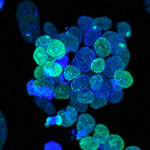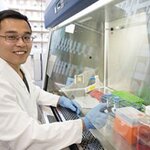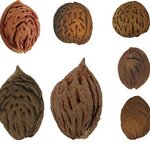Genetics & Molecular Biology

Vitamin B12 is an essential molecule required by most life on this planet but it is only produced by a relatively small group of microorganisms due to its large size and complexity. For us, vitamin B12 plays a key role in maintaining the brain and nervous systems, as well as DNA synthesis in cells throughout the body.
Professors Andew Doxey and Josh Neufeld at the University of Waterloo led a study determining that a single group of microorganisms may be responsible for much of the world's vitamin B12 production in the oceans, with implications for the global carbon cycle and climate…

A decade ago there was mass hysteria among the fringes of science academia because American President George W. Bush limited federal funding for human embryonic stem cells to existing lines. Accompanying claims were that Alzheimer's Disease wouldn't be cured and Republicans hated science.
In 2014, it is difficult to remember what all the fuss was about. California wants its $3 billion in hESC funding back, though that money did finally produce one paper, and adult stem cells have done all of the things hESC research was speculated to be able to do. Now, a final hurdle is about to be…

Rheumatoid arthritis causes chronic pain and inflammation in joints, such as those in the hands and feet, as well as knees and hips. Over time, rheumatoid arthritis can destroy the cartilage that lubricates and cushions the joints. In essence, it 'remodels' bones, leading to disfigurement, pain and reduced mobility.
Cartilage was previously thought to be a victim of an overzealous immune system but a new paper finds it has an active role in rheumatoid arthritis.
Dr Tommy Liu, Professor Ian Wicks, Dr Kate Lawler, Dr Ben Croker and colleagues from the Walter and Eliza Hall Institute made the…

Researchers have revealed an unusual biochemical connection: ft (Fat) genes interact directly with mitochondria in cells.
Mitochondria are the primary sources of energy production within our cells and there are some 200 pathologies linked to mitochondrial dysfunction.
When mitochondria stop working properly, cells no longer have an efficient energy source. Instead, cells will switch to glycolysis to produce the energy they require, known as the Warburg effect. Similarly, tumor cells have glycolytic rates up to 200 times higher compared to normal cells. Since the mitochondria is…

A new study has found that the pond-dwelling, single-celled organism Oxytricha trifallax has the remarkable ability to break its own DNA into nearly a quarter-million pieces and will then rapidly reassemble those pieces when it's time to mate.
Why? No one knows, sometimes nature gets drunk and creates things that make no sense. The organism internally stores its genome as thousands of scrambled, encrypted gene pieces. Upon mating with another of its kind, the organism rummages through these jumbled genes and DNA segments to piece together more than 225,000 tiny strands of DNA. This all…

In order to understand the genesis and treatment of cancer scientists are searching for links between genetic alterations and those diseases.
Historically, most of those studies have focused on the portion of the human genome that encodes protein – about 2 percent of human DNA overall. The vast majority of genomic alterations associated with cancer lie outside protein-coding genes, in what biologists call "junk DNA" and that colloquially became considered junk to the public, even though that is no more accurate than the Higgs boson being an actual God Particle. "Junk DNA" is anything…

If you enjoy a sweet, fleshy peach today, give some thanks to scientifically minded, free-market farmers in China 7,500 years ago.
A new analysis has found that the domestic peaches popular worldwide today can trace their ancestry back to the lower Yangtze River Valley in Southern China at least that long ago. Radiocarbon dating of ancient peach stones (pits) discovered in the Lower Yangtze River Valley indicates that the peach seems to have been diverged from its wild ancestors as early as 7,500 years ago.
Archeologists have a good understanding of domestication – conscious…

In a new study, scientists have adapted a chemical approach to turn diseased cells into unique manufacturing sites for molecules that can treat a form of muscular dystrophy.
In general, small, low molecular weight compounds can pass the blood-brain barrier, while larger, higher weight compounds tend to be more potent. In the new study, however, small molecules became powerful inhibitors when they bound to targets in cells expressing an RNA defect, such as those found in myotonic dystrophy.
Myotonic dystrophy type 2, a relatively mild and uncommon form of the progressive muscle weakening…

A strain of E. coli that is a common cause of outbreaks of food poisoning in the United States has had its genome sequenced. E. coli strain EDL933 was first isolated in the 1980s but gained national attention in 1993 when it was linked to an outbreak of food poisoning from Jack-in-the-Box restaurants in the western United States.
The genome sequence for this historical strain was first published in 2001 but there were many gaps in the genome that could not be closed with the sequencing technology available then. The new sequence unveiled in the journal Genome Announcements is the full,…

A new study finds that 'good' cholesterol is damaged by a sugar-derived substance, methylglyoxal (MG), was found to damage the 'good' cholesterol High Density Lipoprotein - HDL - which removes excess levels of bad cholesterol from the body.
Methylglyoxal is formed from glucose in the body. It is 40,000 times more reactive than glucose and damages arginine residue (amino acid) in HDL at functionally important site causing the particle to become unstable.
Low levels of HDL have been linked to heart disease, with increased levels of MG being common in the elderly and those with diabetes or…